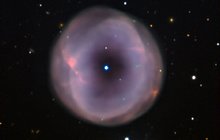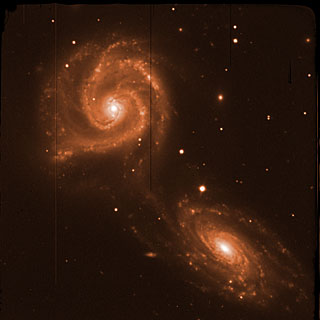EFOSC2
ESO Faint Object Spectrograph and Camera 2
 The ESO Faint Object Spectrograph and Camera version 2 (EFOSC2) was first mounted on the New Technology Telescope (NTT) on 11 May 1989.The instrument was created for one purpose: versatility. Like its predecessor, EFOSC, a robust and multi-purpose instrument at ESO's 3.6-metre telescope at La Silla Observatory (now decommissioned), EFOSC2 could work in any of eight different modes with a strong performance.
The ESO Faint Object Spectrograph and Camera version 2 (EFOSC2) was first mounted on the New Technology Telescope (NTT) on 11 May 1989.The instrument was created for one purpose: versatility. Like its predecessor, EFOSC, a robust and multi-purpose instrument at ESO's 3.6-metre telescope at La Silla Observatory (now decommissioned), EFOSC2 could work in any of eight different modes with a strong performance.
When the EFOSC series was conceived, removing an instrument was not an easy task (and still isn’t!). It takes time, manpower, the need to plug in and unplug hundreds of cables, and most importantly, there is no room for error, otherwise precious observing time is wasted. EFOSC2 was designed with this problem in mind. It is an imager and spectrograph for faint objects, or in simple terms, a device that photographs and analyses the light of the cosmos in multiple ways, and an upgraded version of EFOSC that avoids the necessity of having to add or remove pieces from the instrument.
 In addition to being able to take normal images of the sky, EFOSC2 can be converted into a spectrograph simply by rotating a few wheels. It is then able to split the light from the stars into their individual colours for detailed analysis. EFOSC2 can also be converted into a coronagraph (to observe faint details next to a bright star without being blinded by the star’s glare), and a polarimeter (which measures the polarisation of the light from the stars). That’s not all: EFOSC2 can morph itself into a multiple object spectrograph (to observe several objects simultaneously), or into a spectropolarimeter (to measure the polarisation as a function of the wavelength). The transformation takes only a few seconds.
In addition to being able to take normal images of the sky, EFOSC2 can be converted into a spectrograph simply by rotating a few wheels. It is then able to split the light from the stars into their individual colours for detailed analysis. EFOSC2 can also be converted into a coronagraph (to observe faint details next to a bright star without being blinded by the star’s glare), and a polarimeter (which measures the polarisation of the light from the stars). That’s not all: EFOSC2 can morph itself into a multiple object spectrograph (to observe several objects simultaneously), or into a spectropolarimeter (to measure the polarisation as a function of the wavelength). The transformation takes only a few seconds.
EFOSC2 was successful from the beginning, making the first catalogue of narrowband images of planetary nebulae (Schwarz et al., 1992) still one of most popular works for astronomers!
Once the EMMI instrument (decommissioned) arrived at the NTT in 1990, EFOSC2 was moved to the MPG/ESO 2.2-metre telescope. There, it has contributed with a series of new observations, for example in the field of comets, such as Hale-Bopp (eso9726).
In October 1997, like a family-run business, EFOSC2 replaced EFOSC after ten years of service at the ESO 3.6-metre telescope. Some scientific highlights during that period include work on dark matter in galaxy clusters (eso0419) and also optical studies of supernovae associated with gamma-ray bursts (Levan et al., 2005).
In 2008, and for the fourth time, EFOSC2 was moved once again. This time it went back to the New Technology Telescope after the decommissioning of EMMI. A team was created to update EFOSC2 and give it a new lease of life. As the team explained in an article of The Messenger, the main reasons for the longevity and reliability of EFOSC2 are down to: “the fact that its design is relatively simple, and yet it offers many observing modes and is highly versatile”.
EFOSC2 is still mounted on the NTT, and although it has undergone different improvements over the years, it is still very much an important part of instrumentation programme at La Silla Observatory. With 25 years in operation so far, it still has a lot of life left in it yet, so who knows what the future will be for this intrepid instrument!
Science highlights
- ESO Observations Show Persistent Dust Jets at Comet Hale-Bopp (eso9726)
- Largest Census Of X-Ray Galaxy Clusters Provides New Constraints on Dark Matter (eso0419)
- New Light on the Formation of High Mass Stars (eso0416)
- List of the scientific papers produced by EFOSC2 , via the ESO library TelBib database.
NGC 5427 with EFOSC2
This raw image, straight from the instrument, was used with many others, to produce the photo of NGC 5427 displayed further up this page. The images taken with astronomical instruments are always in black and white, represented here as a scale of colours. The information encoded in the colours of the object is obtained by taking exposures through different glass filters. The black and bright lines are defects of the CCD detector.
A raw spectrum obtained with EFOSC2
A long, narrow slit isolates a small strip of sky. On this image, the slit is horizontal. The spectrograph then splits the light from the slit into its individual colours, with each point along the slit forming a vertical rainbow. In this spectrum, the light from NGC 5775, a galaxy, forms faint vertical bands. The bright vertical line is the spectrum of a star. The horizontal lines correspond to colours at which the sky itself emits light.
EFOSC2The authoritative technical specifications as offered for astronomical observations are available from the Science Operation page.
|

